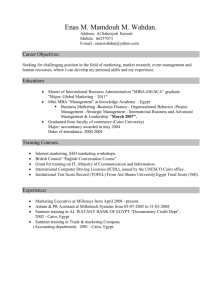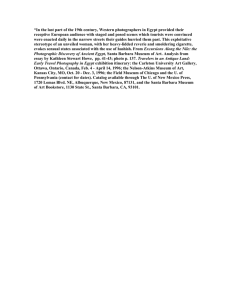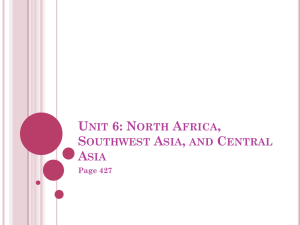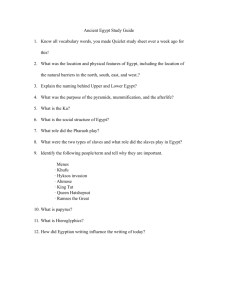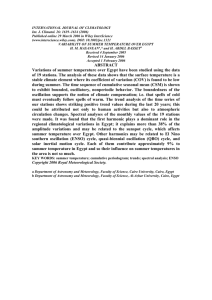dalrev_vol31_iss2_pp129_134.
advertisement
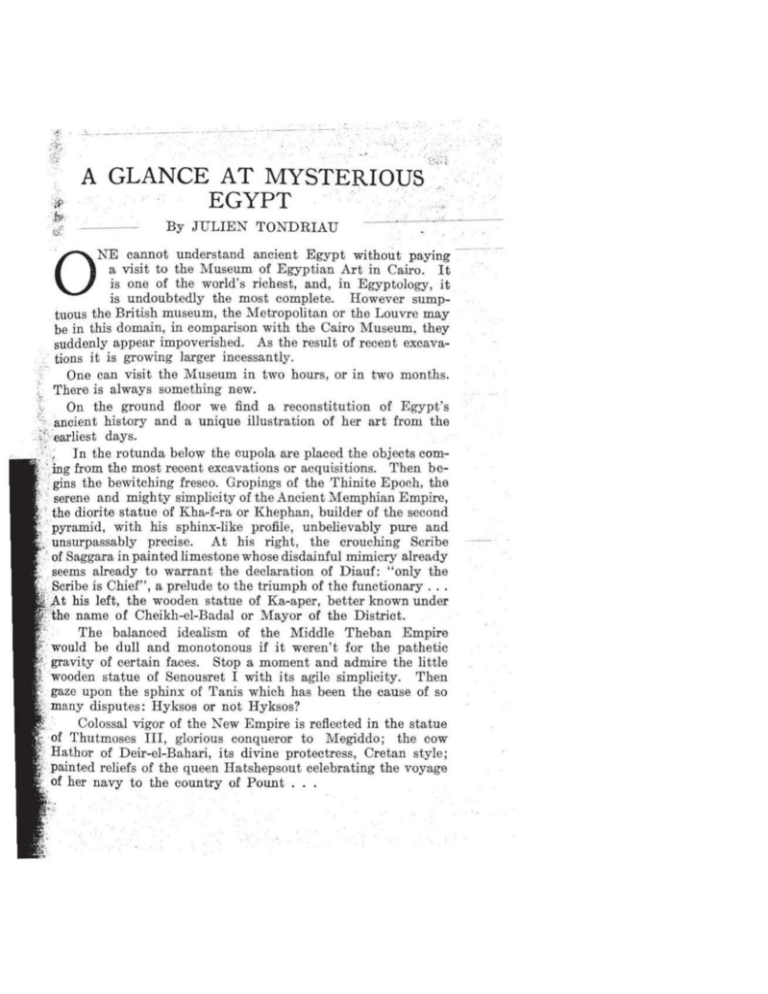
:!·
~(~·
~
- -
.. - -· - -
---
~
" ·.1 .
A GLANCE AT MYSTERIOUS
EGYPT
By JULIEN TONDRIAU
.
-."
}.TE cannot understan.d ancient Egypt without paying -·
a visit to the Museum of Egyptian Art in Cairo. It
is one of the world's richest, and, in Egyptology, it
is undoubtedly the most complete. However sumptuous the British museum, the Metropolitain or the Louvre may
be in this domain, in comparison with the Cairo Museum, they
suddenly appear impoverished. As the result of r ecent excavations it is growing larger incessantly.
One can visit the Museum in two hours, or in two months .
.~ There is always something new.
"'.
On the ground floor we :find a reconstitution of Egypt's
':·. ancient history and a unique illustration of her art from the
-~~"· earliest days.
•'..; In the rotunda below the cupola are placed the objects com~: ing from the most recent excavations or acquisitions. Then be: . gins the bewitching fresco. Gropings of the Thinite Epoch , the
: · serene and mighty simplicity of the Ancient Memphian Empire,
: ' the diorite statue of Kha-f-ra or Khephan, builder of the second
; · pyramid, with his sphinx-like profile, unbelievably pure and
·~. unsurpassably precise.
At bis right, the crouching Scribe
, .' of Saggara in painted limestone whose disdainful mimicry already
: seems already to warrant the declaration of Diauf: "only the
\· Scribe is Chief", a prelude to the triumph of the functionary ...
' .-.i t his left, the wooden statue of Ka-aper, better known under
ll~)he name of Cheikh-el-Badal or Mayor of the District.
? The balanced idealism of the Middle Theban Empire
~:·· would be dull and monotonous if it weren't for the pathetic
~; gravity of certain faces. Stop a moment and admire the little
~; wooden statue of Senousret I with its agile simplicity. Then
· gazo upon the sphinx of Tanis which has been the cause of so
.~: many disputes: Hyksos or not Hyksos?
.
Colossal vigor of the New Empire is reflected in the statue
i~ of Tbutmoses III, glorious conqueror to Megiddo; the cow
,;; Hathor of Deir-el-Bahari, its divine protectress, Cretan style;
:' painted reliefs of the queen Hatshepsout celebrating the voyage
....:. of her navy to the country of Pount . . .
O
130
THE DALHOUSIE REVIEW
Gallery eight, room three: Armanian interlude, sentimental
familiarity, devotion to nature, the sun-cult of Akhnaton,
misshapen visionary of El-Amarna. A long head, an emaciated
face, a feminine pelvis. A gracefulness which is sometimes
monstrous. There is, fortunately, the bust of Queen Nefertiti,
unfinished (the Berlin bust is apparently in America) .. .
Effeminate grace of Ramsesan art, grandiose under Ramses
II.
Ljbyan and Ethiopian epochs. The latest excavatjons at
Karnak prove that one has hitherto underestimated the influence
of the latter period on the Saitan Renaissance which r eacted,
conventionally enough, against Theban influence by a r eturn
to Memphian traditions.
Afterwards one finds the charms of Hellenistic art, delightfully decadent. In one corner of the north wall of tho GraecoR oman room, there is the greyish stone copy of the Rosetta
Stone, the most celebrated inscription in the world . ..
A glance at the Meroitic antiquities (whose inscriptfons, "
like their proto-Sinaitic neighbours, r emain mysterious) and at
the sarcophages, and from thence to the incomparable treasures
on the floor above . . .
One forgets too often the beauty of the possessions of Queen
H etepheres, mother of Kheops; the elegant treasures of Tanis, .,
- -- - beloved by Professor Montet; the room of Graeco-Roman jewels; .
Tod treasures dating from the Middle Empire. One hardly
notices the boomerangs and the millenarian rubber wheels of a.
royal chariot for close by is the fabulous wealth of the tomb ·~
of Tut-Ankh-Amon. One can well imagine Howard Carter
discovering them by the pale light of a torch and crying to
Lord Carnarvon: "Marvels! Marvels!" Marvels which deserve,
in themselves, a trip to Egypt . . . Unbelievable riches, exquisite finesse. How were so many objects placed in such a small ~
tomb? Poor little king, surnamed "Powerful lord- endowed ~
with eternal life" who died consumptive at the age of eighteen, 1
in the supremely re.fined vanity of his gold . .. Blessed chance ,i
which preserved the pillars of his tiny tomb (where his mummy ;::,_~I
still remains) so that the ineffable and dazzling splendours might
be delivered intact to the lovers of beauty . . .
1:
·<&
--
A curious museum, Roman bulwarks, Oriental courts, built
in the nineteenth century. A strange mixture surrounding the
Coptic Museum, founded in 1910 by Morcos Smaika Pacha.
A GLANCE AT MYSTERIOUS EGYPT
131
-
Christian Egypt, infl.uenced by Alexandrian art and afterwards by the Byzantines, influences which still last today. A
technique obsessed by ornamentation, strong colors. A sculpture
affirming its mastership in its architectural :finery, but whose
primitive style, the Oxyrhynchos Bahnasa of Hellenistic fosp:iration becomes more and more austere. Disproportioned and
little varied humans, but refined and graceful animals. Splendid
incrustations in ivory and ebony. Surety of work in metals
and textiles.
An important link in the history of Egypt which one
neglects too often . . .
"
Do not forget a visit to the church of A.bu Sarga. Tradi·tion pretends that the Holy Family spent a month where the
:.. crypt is now found.
<
'
'i
Conceived by Khedive Ismail in 1869, the creation of an
"' .Arabic Museum grouping the artistic treasures of the old mos.,ques was not realized until 1881 under Kjedive Tewfi.k.
,
The most complete and precious collection which exists
rof the evolution of Mohammedan art, too little known by the
,.westerns. Enriched by excavations in the environs of Cairo.
Here again is a magnificent condensation of the history
'of Egypt, this time Mohammedan. Preliminary to the seventh
•o.nd ninth centuries : Islam infiltered under the Rachidites,
:'.Ommyades and Abbassides. Independence under Ibn 'l'ouloun
· ho, smitten by ostentation, built the capital of A.1-Kata'i and
... Dyami' , its mosque-cathedral. A.bbassidin and Ikchididin
interlude (tenth century), harbinger of the glorious Fatimidan
flowering. Construction of the capital in the precincts of three
famous doors which still exist: Bab-El Nasr, Bab-El-Foutouh
and Bab-Zuweilah. The Fatimidans brought to Egypt an
unbelievably sumputous art, stamped with impressive and
harmonious life; admirable jewels in rock crystal, in sculptured
wood. in cloth decorated by inscriptions, in chiselled metal.
Then, Sumnite reaction of the Ayyoubides. enemies of the Crusaders: balanced but severe art. Afterwards fabulous luxury
of the Bahardian and C:ircassian Memeloukes: delicate incrustations in gold, ivo1y and silvflr. But the artistic Renaissance
of the fourteenth century tolled the bell for the Memeloukes,
ruined by the discovery of the route to the Indies, then conquered by the Ottomans in 1517. Three dull centuries waiting
for the activity of Mohammed Ali . . .
First floor of the Arabic Museum. Founded in 1869 by
Khedive I smail. Nearly 150,000 volumes, among them num-
132
THE DALHOUSIE REVIEW
erous editions of the Koran and Persian manuscripts illuminated
with miniatures. A unique collection of papyri, of manuscripts
on parchment or paper, and Arabic ostraca dating from the
eighth century.
In order to know this admirable literature more deeply,
R ene Guenon, a well-known Sorbonne specialist, abandoned
his profession, money and friends, telling no one. Only an
extraordinary chance made it known that, under the name
of Mohammed el Fran!;aoui, he was living in old Cairo, studying
at the University of El Ahzar. Having become a pupil, the
master seemed to have found happiness in "casting off the old
man" . . .
The Mouski, commercial artery of Cairo, and the astonishing
bazaars or souks of Khan el Khalili . . . Startling show-cases,
insidious vendors one cannot resist and who shout exorbitant
prices so that they may bargain . . . Bargaining is the most
subtle of the liberal arts! You will find everything: fried
beans to chewing gum, Chinese porcelain made in I taly and
E gyptian leather coming from I ndia . . . Without mentioning
the myriad antiques, authentically false; the best way to appear
a connoisseur is to declare peremptorily whil e scrutinizing the
object, " It's false!" An odd and colorful cr owd . . . resounding cymbals . . . narghile, Turkish delights, coffee . . .
strange and penetrating odours : spices or mouldiness? . . .
''back sheesh" virtuosi, eighth plague of Egypt . . . gaping
tourists with their blase facade; tourists all too rare because
of the international si tuation, the Egyptians complain.
Cairo, bustling and indescribable, exotic and fascinating.
El Qahira, " the Victorious", which owes its name to the passing
of the planet Mars or El Qahir during the foundation of its
walls in 969 by General Gawbar is also the city of a thousand
minarets, of a thousand mosques. One mu~t choose. We shall
give him some advice, for we have seen them, an experience
which, according to Alber t Sarrault, allows us to be mistaken
with more certitude . .. The Mosque of Amr, primitive Arabic
style, the most ancient, with its twin columns through which
only the Just may pass . . . if he is very slim! The Ibn Touloun
Mosque, Moroccan style, the largest . . . The Mosque of
Sultan H assan imitating the tomb of the Prophet, Oriental
styJe, chef-d'ouvre which cost its architect his two arms "so
that he could make nothing else like it." The Raffai Mosque,
tomb of the royal family, Arabico-Egyptian style. The Mosque
of Mohammed-Ali or of the Two Thousand Lights or the Citadel,
.,
....
.
' s
.~:/
#
;·~r
·."1:..
.
We have heard of the Sphinx and the Pyramids since
f · 'childhood. One feels already acquainted with them for they
have been discussed so much. But never did anyone tell us what
an unforgettable impression one feels on seeing the sun rise on
the prodigious mutilated face of the Sphinx (happily the JYiemeloukes were poor shots) of the llarmakhis millenium.
On the other hand, many people laughed at Paul Brunton,
the journalist who became a Buddhist, who spent a night alone
in the Great Pyramid. Undoubtedly, this orginal fake had
suspicious "apparitions" (to insure the .success of his book
"Secret Egypt"). But tell me, would you have this courage?
-,
What tales hasn't one told about the pyramids since Hero' . dotus' day, passing by the cycle of the golden number of 11:eton,
.
the computations of Bonaparte's scholars, the phantasies of
Proctor or de Persigny, the fraud of one of Piazzi-Smith's
disciples (caught by Sir Flinders Petrie in the act of planning
the granite ledge of the royal antichamber to make it concord
with his ideal measurements) or the "Science mysterieuse des
Pharons" of the Abbe Moreu.""{?
We beHeve we know them . . .
Badrashein, Mit-Rahinah, Saqqara, the d omain of Soker,
god of the dead . . . mastabas . . . pyramids (Dejser, scaled;
Ouserkaf, Teti; Ounas, the first endowed with texts) . . .
Subterranean sarapeum sheltering the gigantic sarcophages
which lack their sacred· bulls . . . Let us go to the South;
Abydos to the mysterious half-submerged Osireion . . . the
temple of Denderah which venerated Hathor-Cleopatra: let
us go by donkey (as Bonaparte's general said before the
battle, "donkeys and scholars together") to the villages :filled
with clay houses . . . Luxor and its obelisk. Karnak and its
impressive hypostyle room which would swallow Notre Dame
de Paris . . . the implacable pink of Deir-el-Bahari .. . Colossi
of Memnon, the second one sings no more . . . Ra,masseum
and its broken giant . . . Medinet Habu, triumph of Ramses
III . . . Ptolemaic grace of Deir el Medina . . . tombs of
the Valley of the Queens and the unforgettable Valley of the
Kings; astonishing paintings, a revelation, are tbey a day old
or were they done thousands of years ago? . . . tombs of the
:
•
"
~
133
Byzantine style where the royal column will not tmn under y~ur
effor.ts :i.f "you are incapable of ma.rrying" . . .
Unless you prefer the charming Mosque of Qa.it Bey in
the Tombs of the Caliphs, bizarre necropolis crammed with the
. living . . .
..
I
i'
',
A GLANCE AT MYSTERIOUS EGYPT
....,
~
.._,
.
"':.
-
-~~u v v oi..n; .t~..t!J
vIEW
Valley of the Nobles: more familiar enchantment. All of that
constitutes the Theban necropolis .. . neighbour of Luxor
. .. temple of Edfu with its innumerable black bees . . .
Kom-Ombo by car, " donkey back on rails," from the sugarrefinery . . . Elkab and Kolah (another scaled pyramid but
set, this time, by angles), sites of the Belgian excavation of
the Foundation Elisabeth . . . Elephant Island and the
Nilometre which evokes Strabo . . . hypogea of the hill . . .
Aswan, the career of the obelisks, the first cataract, the primitive Busharins, the island of Philae almost under water . . .
We believe we've seen everything, at least down to Sudan . ..
But there is something new at each step . . .
"Can one discuss the history of Egypt and its monuments without having seen the country?" Professor Bikerman
asked me in New York last year. It would be tempting to
reply, unparadoxically, "Undoubtedly, but when one has seen
them, would one dare to again?'~
l
~
.
j:
'~: ·
I
•
